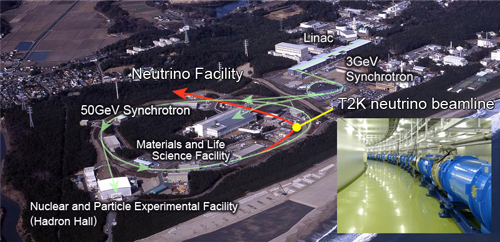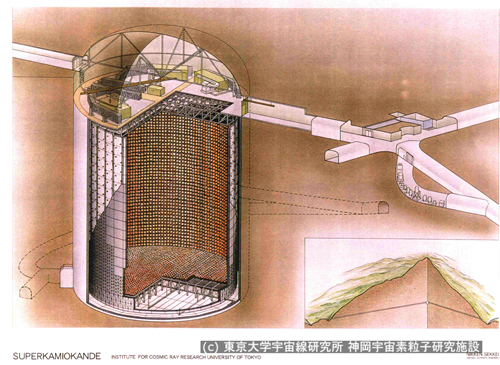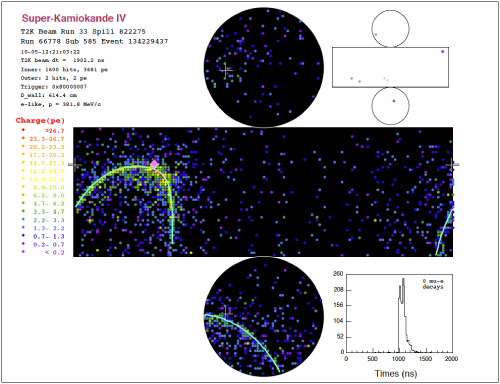
Press Release
Indication of Electron Neutrino Appearance at the T2K Experiment
June 15, 2011
T2K Collaboration
High Energy Accelerator Research Organization (KEK)
Institute for Cosmic Ray Research, The University of Tokyo
J-PARC Center
Tsukuba, Japan, June 15, 2011. The T2K experiment, whose primary purpose is to study neutrino interactions at a large distance from their source, has detected 6 electron neutrino candidate events based on the data collected before March 11, 2011. For the first time, it was possible to observe an indication that muon neutrinos are able to transform into electron neutrinos over a distance of 295 km through the quantum mechanical phenomena of neutrino flavor oscillations.
The T2K experiment*1 aims to search for neutrino*2 oscillation, phenomena in which a particular types of neutrinos transform into other types of neutrinos. These observations help to determine neutrino masses, as well elucidating the uncharted nature of neutrinos such as the relationship among three neutrino generations (types). T2K aims at the world’s best sensitivity by detecting neutrinos with the Super-Kamiokande detector*3 in Kamioka in Gifu Prefecture, Japan, situated 295 km away from the Japan Proton Accelerator Research Complex (J-PARC)*4 where the muon neutrinos are produced. In particular, observing oscillations from muon neutrinos to electron neutrinos (electron neutrino appearance) is the primary goal of the T2K experiment*5. Observing the appearance of electron neutrinos will determine the research direction of neutrino physics in the future, as well as provide the most promising clue to the mystery of the matter dominated universe, and thus researchers around the world draw special attention to and compete in such observations*6. The T2K experiment, claiming the world’s best sensitivity, has internationally attracted more than 500 researchers from 12 countries.
Based on the analysis of all data collected by the T2K experiment between January 2010 when it began full operation and March 11, 2011 when it was interrupted due to the great East Japan earthquake, 88 neutrino events were detected by the Super-Kamiokande. Six candidate events cleanly identifiable as electron neutrino interactions were identified out of these eighty-eight events.
When electron neutrinos interact with matter, electrons are produced. However, electrons are also observed with some probability in background events other than the electron neutrino appearance. In the current T2K experiment, 1.5 such background events were expected to be detected and thereby the probability of the existence of electron neutrino appearance is estimated to be 99.3%*7, suggesting the appearance of electron neutrinos for the first time.
The T2K experiment collected about 2% of the original goal of the total number of events to be collected before the great East Japan earthquake hit on March 11, 2011. After J-PARC resumes producing muon neutrinos, which is planned to happen by the end of 2011, the T2K experiment will continue striving to accumulate the target number of events to confirm electron neutrino appearance, as well as pursue the further understanding of this appearance by combining the neutrino measurements with measurements using anti-neutrinos, which is also the purpose of this experiment. Additionally, the researchers aim to search for CP violation*8 in leptons*9 to explore the origin of matter in the universe by upgrading the accelerators at J-PARC to much higher intensity and enhancing the performance of the detectors. Electron neutrino appearance is the key to detecting leptonic CP violation, and the current observation result indicates that the T2K experiment has made a significant step towards this future goal.
[Media Contact]
- About T2K Experiment
-
Takashi Kobayashi
The Institute of Particle and Nuclear Studies, KEK
TEL : +81-29-864-5414
- About J-PARC and KEK in general
-
Koichiro Nishikawa
Director, The Institute of Particle and Nuclear Studies, KEK
Deputy Director, J-PARC Center
TEL : +81-29-879-6037
- Scientific inquiry about Super-Kamiokande, a far-end detector
-
Yoichiro Suzuki,
Director, Kamioka Observatory, The Institute for Cosmic Ray Research, The University of Tokyo
TEL : +81-578-85-9601
- About J-PARC Center (Public Relations)
-
Kunihiro Suzuki
Public Relations Section leader, J-PARC Center
TEL : +81-29-284-3587
- About KEK (Public Relations)
- Youhei Morita
Head of Public Relations Office, KEK
TEL : +81-29-879-6047
Schematic View of the T2K Experiment and Aerial View of J-PARC


In J-PARC, protons are accelerated in a linear accelerator and accumulated in a 3 GeV synchrotron, and then injected into a main ring (MR). These protons are subsequently extracted from MR by kicker magnets and bent toward Kamioka, then collide with a target to produce neutrino beams, which finally travel to Super-Kamiokande. A part of these neutrino beams are measured with near detectors at J-PARC. By combining these two measurements, study on neutrino oscillations, in which a particular type of neutrinos transforms into other types of neutrinos while traveling, will become possible.
J-PARC Neutrino Experimental Facility

Super-Kamiokande Detector

A Candidate Event of Electron Neutrinos at T2K

In this projected diagram of cylinder-shaped Super-Kamiokande, each colored dot shows a photomultiplier that detected light (these photomultipliers are mounted on the inside wall of the detector). Electron neutrinos interact with water in the detector to produce electrons, which subsequently induce electromagnetic showers to eventually emit Cherenkov light that is detected as a ring-shaped structure.
Glossary
- *1 T2K Experiment (T2K Long Baseline Neutrino Oscillation Experiment)
- A long baseline neutrino oscillation experiment, where neutrino beams produced at J-PARC is detected with Super-Kamiokande, a neutrino detector, located in Kamioka in Gifu Prefecture 295 km away from the J-PARC. T2K (Tokai to Kamioka) was named from the first letters of Tokai where J-PARC is located and Kamioka where Super-Kamiokande is located. One of the primary purposes of the T2K experiment is to detect electron neutrino appearance. The T2K experiment, which has the world-leading sensitivity for neutrinos, has attracted many researchers around the world, and in fact more than 500 researchers from 12 countries: Japan, US, UK, Italy, Canada, Korea, Switzerland, Spain, Germany, France, Poland, and Russia have joined this international experiment. In Japan, about 80 researchers and students from KEK, the Institute for Cosmic Ray Research of The University of Tokyo, Osaka City University, Kyoto University, Kobe University, The University of Tokyo, and Miyagi University of Education participate in this experiment as core members.
- *2 Neutrinos
- A type of elementary particles. Neutrinos are electrically neutral and their masses are postulated to be about one hundredth of quark or electron masses. Neutrinos come in three types: electron neutrinos, muon neutrinos, and tau neutrinos.
- *3 Super-Kamiokande
- A detector affiliated with Kamioka Observatory of the Institute for Cosmic Ray Research, the University of Tokyo and situated 1,000 m underground in the Kamioka Mine in Hida, Gifu Prefecture. Super-Kamiokande is observing neutrinos from outer space and conducting experiments to detect yet-to-be-discovered proton decays in addition to the T2K experiment. This detector contains about 11,200 photomultiplier tubes, which are installed on the inside wall of a cylindrical water tank (39.3 m in diameter and 41.4 m in height) filled with 50,000 tons of water, to detect faint Cherenkov light.
- *4 Japan Proton Accelerator Research Complex (J-PARC)
- The collective designation of proton accelerators and associated facilities in Tokai, Ibaraki Prefecture, jointly established by the High Energy Accelerator Research Organization (KEK) and the Japan Atomic Energy Agency (JAEA) in 2001. J-PARC is conducting leading-edge academic research in material, life science, and nuclear and elementary particle physics as well as seeking for their industrial application through the utilization of secondary particles, such as neutrons, muons, mesons, and neutrinos, produced by colliding accelerated protons with nuclear targets.
- *5 Oscillation from muon neutrinos to electron neutrinos (electron neutrino appearance)
- If two different types of neutrinos have different masses, they can transform into each other while traveling. This phenomenon is called neutrino oscillations, which was predicted by Pontecorvo and Maki, Nakagawa, and Sakata in 1962. Neutrinos come in three types: electron neutrinos, muon neutrinos, and tau neutrinos, and thus three patterns of oscillations may occur between electron neutrinos and muon neutrinos, muon neutrinos and tau neutrinos, and tau neutrinos and electron neutrinos. Neutrino oscillations were first confirmed by Super-Kamiokande in 1998 through the observation that the number of cosmic muon neutrinos decreased more significantly than expected. Such oscillations can be understood as an oscillation between muon neutrinos and tau neutrinos. In addition, oscillations in which electron neutrinos transform into muon neutrinos or tau neutrinos were detected in the observation of solar neutrinos and that of neutrinos from nuclear reactors (the number of detected electron neutrinos decreases more significantly than expected). If another type of neutrino appearance from muon neutrinos to electron neutrinos is detected, the ratio of the three types of neutrino oscillations can be determined; thereby many studies have been conducted around the world to detect such events, but nothing has been successful because its amplitude is very small. This is a special type of neutrino oscillation studies, in which different types of neutrinos are identified before and after the oscillation unlike oscillations of atmospheric neutrinos or solar neutrinos, and thus this study can be the best candidate to search for CP violation*8 in leptons*9.
- *6 Neutrino oscillation experiments in other parts of the world
- Neutrino oscillation experiments using accelerators are also being conducted by the MINOS experiment at the Fermi National Accelerator Laboratory (Fermilab) to the Soudan Underground Mine State Park in the United States, and the OPERA experiment at the European Organization for Nuclear Research (CERN) in Switzerland to the Gran Sasso National Laboratory of Italian National Institute for Nuclear Physics (INFN), in Italy. Fermilab is also preparing yet another neutrino oscillation experiment, NOvA, which will be a strong competitor of the T2K experiment. In addition, several new types of neutrino oscillation experiments using neutrinos produced by nuclear reactors are being prepared by the Double-Chooz experiment in France, the Daya-Bay experiment in China, and the Reno experiment in Korea.
- *7 Probability of events in which electron neutrinos appear
- Events detected by Super-Kamiokande as electron neutrino events may contain background events that are not caused by electron neutrinos at a certain percentage. Computer simulations are used to estimate such background events; however, because the probability of background events is governed by statistics, the estimated number of background events distributes around a specific average value with a statistical error. For the six observed electron appearance events by Super-Kamiokande, the average number of background events is estimated to be 1.5 and thus a probability that all these six events are background is 0.7%, indicating that the significance that electron neutrino appearance events were actually observed in the current experiment is 2.5 sigma, or 99.3%
- *8 CP violation
- CP violation claims that the characteristics of particle natures between matter and antimatter differs with each other. CP violation is thought to be a condition why the universe mostly consists of matter but not antimatter (matter dominated universe). Lepton CP violation is thought to be especially the key to it.
- *9 Leptons
- A group of elementary particles including electron and its family particles and neutrinos that have no electric charge. As with quarks, there are six types of leptons: e (electron), νe (electron neutrino), μ (muon), νμ (muon neutrino), τ (tau), and ντ (tau neutrino). These leptons are thought to correspond one-to-one with six quarks: u (up), d (down), c (charm), s (strange), t (top), and b (bottom); however, detailed nature of this correspondence has yet to be elucidated. In particular, there has been still a mystery why muon, muon neutrino, tau, and tau neutrino exist. Please note that leptons have their antiparticles, termed antileptons, as quarks have antiquarks. Antielectron is especially called positron.